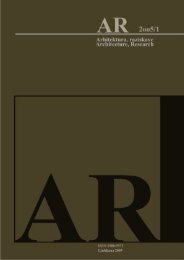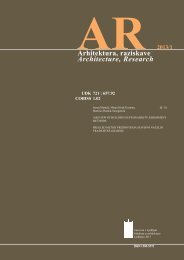Mateja Dovjak, Roman KuniÄ - Fakulteta za arhitekturo - Univerza v ...
Mateja Dovjak, Roman KuniÄ - Fakulteta za arhitekturo - Univerza v ...
Mateja Dovjak, Roman KuniÄ - Fakulteta za arhitekturo - Univerza v ...
- No tags were found...
You also want an ePaper? Increase the reach of your titles
YUMPU automatically turns print PDFs into web optimized ePapers that Google loves.
AR 2011/2EditorialThis year, there have been three issues of AR: the additionalone will be a thematic issue dealing with 'stone'. But thepresent issue also offers a number of interesting reflections.Professor Vladimir Bre<strong>za</strong>r deals with the interesting themeof selecting the length of construction elements. In thearticle Pragmatic construction, or the 4-metre syndromehe discusses the history of architecture, which is a historyof continuing efforts to bridge ever-increasing spans and,accordingly, ever-increasing spaces. More than two thousandyears of such development can be found in any history ofarchitecture treating monumental buildings made fromsolid and durable materials. The 4-metre syndrome is a veryspecial phenomenon within this context.It is worth reading.A young colleague, Srđan Nađ, returned from the U.S. with anumber of interesting items of information. He has collectedhis reflections in the paper Mies van der Rohe's influenceon multi-dwelling architecture in Chicago, pondering on theworks of the great architect. He claims that a quick sightseeingtour of the city quickly reveals that many Chicagoarchitects adopted the concept of the façade, or merely thevisual appearance of a structure, following the model ofMies's architecture. Some even emulated the whole design ofMies's residential structure.An issue which some of us are increasingly becoming awareof, and which has been dealt with on several occasions, is oldage. Slovenia is getting old; this is a fact. Has architecturebeen following this development? Boštjan Kerbler presentsa number of estimates and suggestions in his article Smarthomes for independence and quality of life for the elderly.He claims that due to the rising costs of health and socialservices, the ageing population is becoming an increasingchallenge for all developed societies. Therefore, achievingfinancial sustainability increasingly requires that theseservices be rationalised. One of the responses of society tothese problems is the idea that services should be 'transferred'to the residences of older people, which also means changingin architecture in response to this development.Brankica Stojnić, a PhD student, ponders the re-evaluationof boundaries between the public and the private. The articleRedefining the boundary: multiple realms of the privateand public in modern architecture raises the problems ofsome key elements blurring the distinctions between thesetwo categories. She says that an insightful understanding ofthese problems is essential for addressing the problems ofchanging physical boundaries.Miha Praznik and Martina Zbašnik-Senegačnik areconcerned with the regulation of energy consumption inhouses. The article Analysis of qualitative parameters forenergy-efficient houses analyses many buildings havingvarying degrees of efficiency depending on their size, numberof occupants, location in space, shape factor and materials.It seems that highly energy-efficient family homes emerged inSlovenia around 2005, and were becoming more numerous in2008. Since energy efficiencies vary, thoughtful considerationwhen making a choice is increasingly important.<strong>Mateja</strong> <strong>Dovjak</strong>, a colleague from the Faculty of CivilEngineering and Geodesy, and a practice expert, Dr <strong>Roman</strong>Kunič, try to shed light on an issue already discussed inAR some years ago: greening. The paper Green buildingelements and the urban heat-island effect broadens andupdates the issue. It reports on green roofs, exterior wallsand building envelopes. The authors claim that greenbuilding elements have become increasingly popular inthe last few years. They are passive technologies employedto solve modern city problems and thereby contributeto the sustained development of the urban environment.The authors investigate the contribution of green buildingelements to solving the heat-island effect issue and hugeenergy consumption in buildings. Above all, this is a greatarchitectural challenge.This is not the last of the papers by PhD students, whichdominate this issue. A young colleague, Sabina Jordan, alongwith her mentor Prof Martina Zbašnik-Senegačnik, presentsanalyses and the influence of glazing on two different yetinteracting levels - the building as a whole and glazing asa building element. The authors focus on glazing as such,which in today's architecture too often constitutes a problem.The paper Analyses and influences of glazed buildingenvelopes contains quite a lot of critical reflection. At thebuilding level, analyses were performed on a sample of highrisecommercial buildings in Slovenia. These reflections areespecially relevant when decisions about this type of buildingare being made.One of the better articles is Identifying dispersed developmentin preparing municipal and communal spatial plans whichdeals with a policy about which there is much discussion butwith which we are far too unfamiliar. Therefore a responsefrom the practical field is much more important. MojcaFurman Oman writes about the absence of methods fordetermining dispersed housing, which thus leads to a lackof standardisation and confusing municipal and communalspatial plans, which take completely different approaches tosettlements in rural areas.The model is one of the oldest types of representation inarchitecture. In the course of history, it has not changedmuch, but the last few years have seen a turning point inits evolution: it appears as a physical model and as a virtualspace that we may discover as circumstances require,verifying details which once remained concealed until thefinal realisation. In their article Models in the digital designprocess, Luka Jančič and Fedja Košir discuss the use ofmodels in the design process and highlight the changesintroduced to this field by new digital modes of design andimplementation.Maša Pahor, a PhD student and researcher from theeconomic sector, deals with renovation. She claims that inSlovenia there is a considerable divergence between wishesand goals respectively and the actual situation regarding therenovation of multi-dwelling structures. The implementationof comprehensive renovations - due to the great share ofprivate property share and financial incapacity of owners –is extremely difficult, a judgement with which we can fullyagree.The third issue will then be devoted to stone; in the first issueof 2012, we will also publish conference proceedings as wellas research reports from 2011; these are quite numerousand concern the response to our scholarly work, which is anecessity for this area of research.The Editor1

















